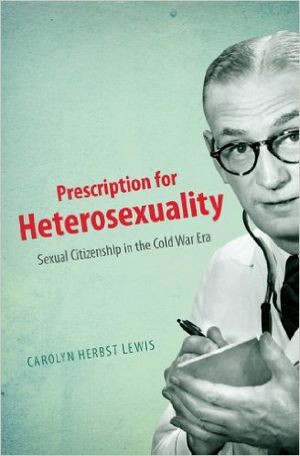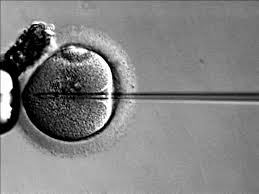The Cold War, Sexuality, and American Medicine: Interview with Carolyn Herbst Lewis
DailyHistory.org published a Top Ten History of Sex Booklist. Carolyn Herbst Lewis's outstanding book Prescription for Heterosexuality: Sexual Citizenship in the Cold War Era (Chapel Hill: University of North Carolina Press, 2010) was on the list. Not only was her book on the list, it received by far the most interest from our readers. Recently, her book was reissued as a trade paperback by UNC Press and we wanted to talk to her about it. Carolyn Herbst Lewis is currently a Assistant Professor of History at Grinnell College in Grinnell, Iowa. Her current research focuses on Dr. Joseph Bolivar DeLee and the Chicago Maternity Center.
Lewis's profile from Grinnell provides an excellent summary of her book: "Prescription for Heterosexuality considered the definitions of sexual health crafted by the American medical profession in the postwar decades. By examining the material published in the profession’s journals and other venues, Lewis revealed the connections that physicians made between individual sexual adjustment, family stability, and national security during the Cold War. Her book addressed not only the historical construction of heteronormativity in the mid-twentieth century United States, but also the forces shaping professional shifts in American medicine in this same period, as well as the overlap between the two." Here's our interview:
Your book tells a fascinating story about the role family physicians tried to play in their patients’ sex lives. What first attracted you this story?
This book actually has its origins in my MA thesis at Ohio University. I had been drawn to the history of sex since I was an undergrad. I also was working in the Contemporary History Institute, which has a post-1945 focus. At some point, I was at a garage sale and found a book from the 1970s about how psychoanalysts were adapting their practices to accommodate the women’s liberation movement. It was a sort of an “A-ha!” moment, when my interests in sexuality, medicine, and culture converged in a meaningful way. From there, the question that emerged as I proposed my thesis topic was “How did the American medical profession respond to the Kinsey Report in 1953?” This led me to medical journals as my source base, and eventually the larger project grew from there. By the time I was working on my dissertation at UCSB, I could see how this was a story not just about sex, but also about authority, citizenship, and defining gender normativity.
Before I start writing a research project, I find that I’m never quite sure what my research is telling me. At some point when I am writing a light bulb clicks on and I go, “oh, that’s what this is all about.”
Did that happen to you when you were writing this book or did your original conception of this project survive the writing process?
You know, when you’re in the dissertation zone, which is where the first full draft of this book was written, it can be very difficult to acknowledge what is significant about your work. In many ways, as I indicated earlier, there is a clear path from the MA thesis to the book. It’s remarkable how much is unchanged. At the same time, there were all sorts of moments along the way when things clicked. I really have to thank my cohort at UCSB in History and Feminist Studies for this. I remember once I was in a research seminar, and April Haynes was practically pulling words from my mouth, trying to coax me into articulating how the premarital pelvic exam was related to citizenship. I also tried to go down different paths with this project that had to be abandoned. They were sort of the opposite of click moments – moments when I realized what I was trying to do made no sense at all, or that it was too much of a stretch. I think in some ways, those moments are even more significant. It’s hard to abandon work, but sometimes it’s necessary. For example, I spent a lot of time trying to work in a chapter about rape kits. I’m not sure I even remember what I was trying to do, but at the time, it seemed really important to the performance of heterosexuality. Now, I cannot even imagine how I would make that work.
The creation of family medicine occurred contemporaneously to physicians' efforts to treat, regulate and guide their patients’ sex lives. Why did the family physicians specialize in sex instead of another field? Were family physicians motivated more by money or a deep seated desire to guide their patients’ morality?
Well, I don’t think they were trying to specialize in sex. They were specializing in the family unit, and the family unit is created through reproduction (assisted or unassisted), and that is one way the sex comes in. Sex also was essential to individual character and emotional/mental health, and family units were best created by healthy individuals. That is another way sex comes into it. Their concern was with gender more broadly, and sexual desires and acts were linked to gender performance. I’m looking at the ways that plays out. As for their motivation, I think it’s important to remember that these doctors were not bad people. They did not wake up in the morning and set out to harm people in any way. They wanted what was best for their patients; we just disagree with how they defined what was best. But that is always tangled up with the desire for professional success and prestige. This was their profession, maybe even their vocation, and they wanted to be successful. Success was defined not just by helping their patients be healthy, but also by the usual measures of professional success – some recognition by their peers and a comfortable lifestyle.
I find that the further we get away from the Cold War the more difficult it is to explain to younger students the impact that paranoia and anxiety of the war had on American society. This is problematic because the Cold War shaped American society and it even plays a role in your story. What role does the Cold War play in your book? Additionally, how do you explain to students the impact of the Cold War (an ideological and military conflict between the USSR and US) on American sex? When I looked at the larger discussions taking place in the medical journals, I saw a Venn diagram with three circles: one was discussions about sexuality and reproduction; one was discussions about the family medicine specialty; and one was anxiety about the Cold War. I was interested in the place where those three circles overlapped. The Cold War entered into medical journal articles in really surprising ways. I did not expect this. Yet, it was right there. An article about how to talk to your patients about their sex lives, and the author makes reference to how the Soviets were trying to undermine our values. Or how without good sexual values, our society will crumble with just a little outside pressure. In an era in which physicians were also writing articles about how to prepare for civil defense in the likely event of a nuclear attack, this was especially meaningful. The Cold War clearly drove a lot of the assumptions regarding gender and sexuality in this era, and it was no different in the medical journals than anywhere else.

As for how to explain the impact of the Cold War, whether on sex or anything else, I don’t find it that difficult. Students today have grown up in the shadow of 9/11. In the spring, I taught an introductory level course in American Cold War Culture. A lot of the material resonated with the students. This is not to say that the eras are the same; I certainly do not mean that at all. But they “get it.” And, as one student told me, now they “get” their parents and grandparents, too.
Why were American physicians so slow to reject “morality medicine”, i.e. the narrow moral views expressed by medical profession on abortion, masturbation and venereal disease? Has this “morality medicine” persisted in medicine?
Oh, I certainly think there is morality medicine today. Homophobia is not gone. The belief that children are best cared for full-time by their mothers is not gone. One of the bloggers for Nursing Clio recently wrote about how a Canadian fertility clinic refused to inseminate a woman with sperm from a donor of a different racial background than hers. Infertility, pregnancy loss, abortion, STIs, multiple partners… I probably have enough anecdotes of comments made by health care professionals to patients during pelvic exams and other visits to fill another book. And how about obesity, cholesterol, diets, exercise? All of those discussions are loaded with moral assumptions. And those assumptions are further coded by class, race, and other stereotypes.
Do the debates about artificial insemination described in your book mirror some of the debates about in vitro fertilization (IVF) from the 1970s and 1980s? Today, both artificial insemination and IVF are relatively non-controversial. Was it the changing views of American sexuality or the increasingly commonplace nature of these procedures that killed opposition?
Hmm. I’m not sure that they are non-controversial. I mean, how many people broadcast the fact that their children were conceived with donor sperm – especially if it is a married, heterosexual couple? Why is that if not because it is controversial in some way? IVF is definitely more common, but I suspect that people who experience the world of assisted reproduction would say that there are all sorts of assumptions, insults, and fears that they hear from others. Assisted reproduction is non-controversial in the sense that most of us accept that it occurs (and probably all know someone who has used some form of it), but that doesn’t mean that we don’t imbue it with all sorts of moral judgments. And the fact that assisted reproduction is expensive, and not always fully covered by medical plans, means that we are gate-keeping who can and cannot reproduce.
How would you recommend using this book in a class? What can students find in your book that they can’t find anywhere else?
There is excellent literature on the history of sexuality, the history of sexual citizenship, the history of postwar family life, and the history of medicine. What do I bring to the table? I tie it together. This is not a comprehensive narrative by any means. But this story about how the American medical profession defined healthy sexuality in the postwar decades is one thread of it that needs to be understood. Moreover, I think it is important to examine the deliberate construction of heterosexuality. If we don’t put the medical construction of heterosexuality under the same microscope that we put the medical construction of homosexuality, then we are suggesting that heterosexuality was not constructed by medical processes. This is a mistake that helps perpetuate heteronormative privilege. And I think it’s the same with male sexuality and masculinity in comparison with female sexuality and femininity. If we don’t interrogate male sexual and gender performances to the same degree that we interrogate female sexual and gender performances, then we help perpetuate male privilege.
I’m not sure that really answered your question, though, and perhaps this won’t either, but two things that I think people overlook about my book is a) that it offers a history of medical professionalization and specialization in the mid-twentieth century, and b) that it offers a history of artificial insemination and social fatherhood in the 1950s and 1960s.

